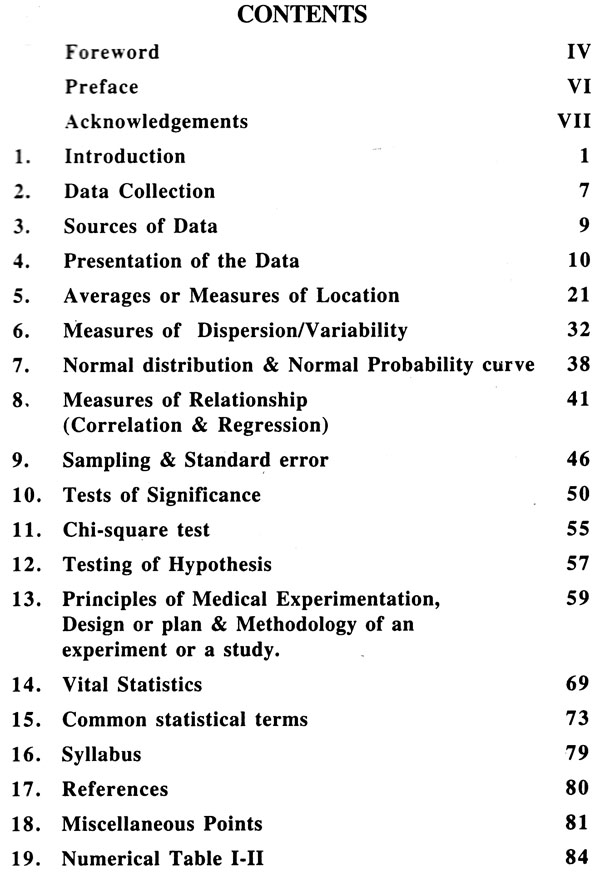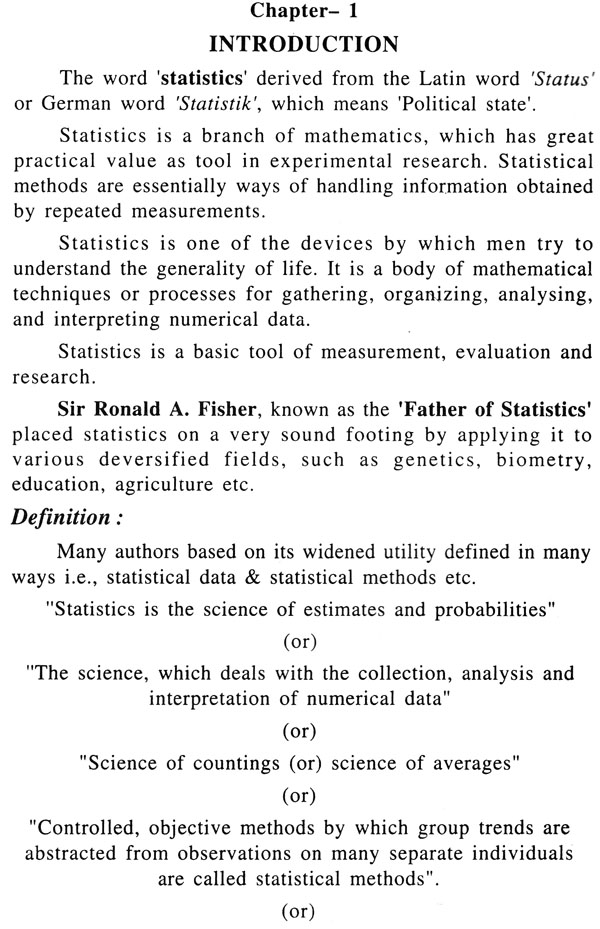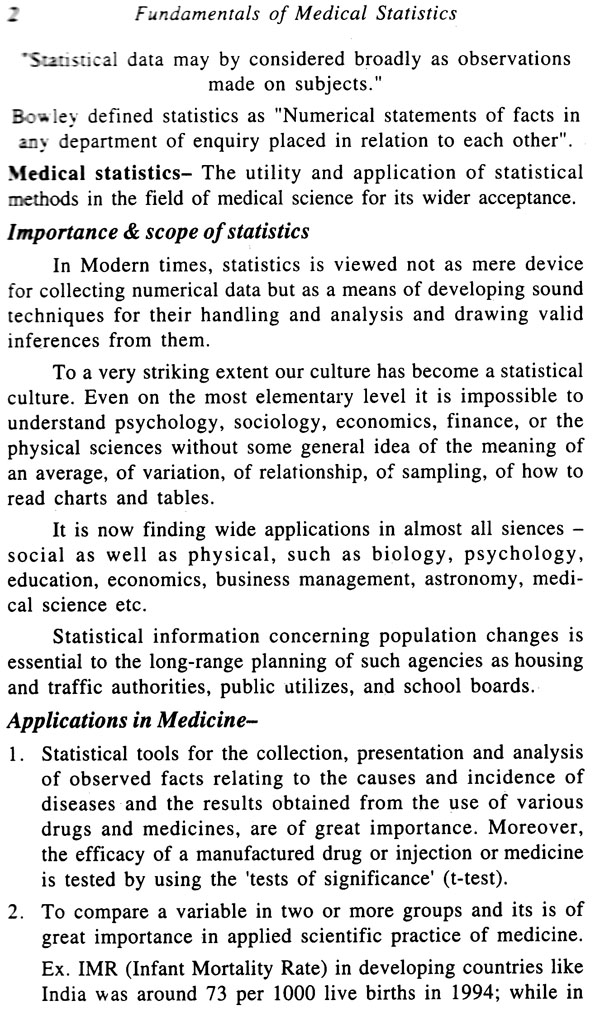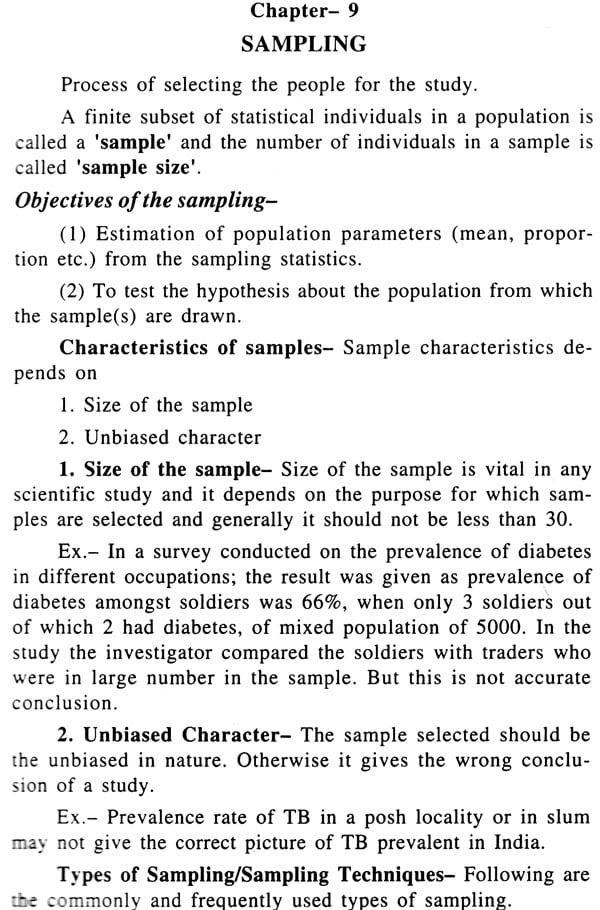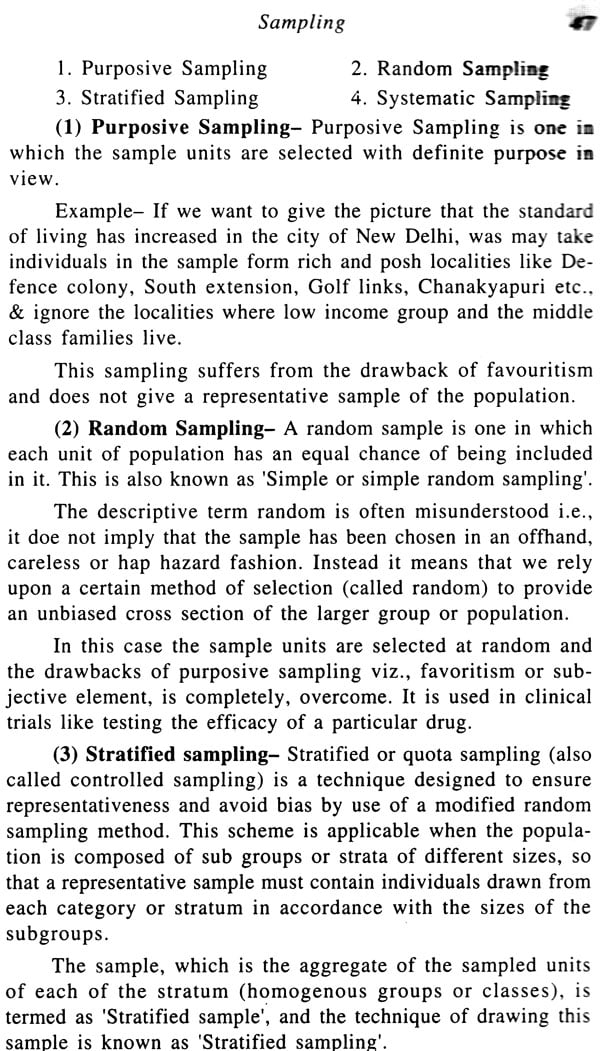
Fundamentals of Medical Statistics for Ayurvedic Scholars
Book Specification
| Item Code: | NAU949 |
| Author: | Sr. Sathyanarayana Dornala and B. Saidulu |
| Publisher: | CHAUKHAMBHA ORIENTALIA, Varanasi |
| Language: | English |
| Edition: | 2016 |
| ISBN: | 9788176371247 |
| Pages: | 94 |
| Cover: | PAPERBACK |
| Other Details | 8.50 X 5.50 inch |
| Weight | 110 gm |
Book Description
This book is intended as a text for Post-Graduate Scholars of Life-sciences and in particular scholars of Ayurvedic medicine. This was written keeping in view of CCIM curriculum for P.G. Education in Ayurveda. An effort has been made to present the material with such simplicity and clarity as to make it almost self-instructive to the teachers and scholars of non-mathematical background.
Dr. Sathyanarayana Dornala, Graduated from GAC, Hyderabad and presently working as a Research Scholar of M.D. (Ayu.) at Post-Graduate Dept. of Kaya Cikitsa (Internal Medicine), Dr. B.R.K.R. Govt. of Ayurvedic Medical College, Hyderabad, A.P. Author presented and participated in many National and International seminars on Ayurveda. Author is interested in Teaching, social service and active student leader. The Co-Author of this book Mr. B. Saidulu, is a Chemical Engineering with Sound Mathematical background, presently working as Deputy Director of A.P. Forest Academy, Hyderabad & he contributed the entire mathematical part of the book.
Medical Statistics is defined as quantitative medicine. 'Statistics' is the essential part of the modern research in general and medical research in specific. Statistics constitute an integral part of every scientific enquiry. It affects everybody and touches life at many angles.
Human creation is considered unique in the evolution of life. In contrast to other forms of animal life, their well-developed nervous system has enabled them to develop sounds and symbols as well as letters and numbers. Hence forth, the communication and recording of their questions, observations, experiences, ideas and skills is possible.
It is interesting to find the Indians at the top positions in IT industry/computer sciences world-over. I personally feel that this could be possible because of our genetic predisposition to SANKHYA PHILOSOPHY which is nothing but digitalization (SANKHY = digit). One seldom agrees with our ancient philosophy but today we have digitized pictures, sounds neither what nor everything.
When we look into ancient Indian mathematics (BHASKARA GANITA), we find a principle called CHANDYASCHIDYADI YOGA wherein the theory of combinations & permutations much in advance to Europeans. Rasa Sankhya (total number of combination of tastes) is given as the example for it. Other references about the statistics are traced from Caraka's observations wherein he ad-vised height, waist circumference etc., measurements on the basis of each individual (SVENA ANGULI PRAMANENA) and not basing up on the simple arithmetic mean/average. This was in order to avoid errors or variability. Caraka expresses the theory of prob-ability through the context of Pramana Pariksha where he quoted that— if the anatomical structure is in accordance with the given measurement its physiology is expected to be normal. We have several examples to quote to inform about the ancient Indian wisdom.
The authors have attempted to provide an introduction to statistical methods, which is modern, intuitive and non-mathematical. Simple numerical examples and graphic devices help to maintain the clarity of exposition. Statistical concepts in the book were dealt in relation to real problems. The subject matter is presented in a very simple and useful way in the present work. The text started with general introduction on Statistics followed by data collection. Different concepts related to sampling, standard errors, significance tests are lucidly explained. In the end research methodology with special reference to medical statistics is explained along with the vital statistics. The final chapter dealing with the common terms used in statistics will be really useful for the learners. Over all this work covers the requirements of PG scholars of Ayurveda.
The insufficiency of subject-based textbooks in the field of Ayurvedic Education is a grave problem. This work which is based on CCIM syllabus for Medical Statistics is indeed helpful to the student as well as the teachers of Ayurveda. I also congratulate the publishers CHAUKHAMBHA ORIENTALIA, VARANASI for bringing in this work for the utility of scholars and teachers. Earlier they have published a book on Re-search Methodology for the P.G. scholars and with this text they are providing complete subject based texts for Research Methodol-ogy and Medical Statistics for the P.G. Scholars of Ayurveda. I congratulate the authors for their endeavor to provide good medical statistics to the Ayurvedic fraternity. I also wish simi-lar good publications form M/s Chaukhambha Orientalia, Varanasi.
Ayurveda is nor only the ancient Indian medicine but it claims to be the first systematic medicine ever evolved through-out the World. Modern problems and needs are forcing statistical methods and statistical ideas more and more to the fore. There are so many things we wish to know which can not discovered by a single observation, or by a single measurement. The repeated observations or measurements are important for the statistical data. There is a myth that the statistical techniques are not applicable to Ayurvedic standards at many times. But it is not true that there are some instances where statistical methods hold fit in this field of Ayurveda. This book has been written to use as a reference or a text in the examinations of Research methods and statistics. It is appropriate for Research Scholars enrolled in a research seminar, for those writing a thesis or dissertation, or for those who carry on research as a Professional activity. All research scholars should be familiar with the methods of research and the analysis of data, which is the base for the interpretation and critical analysis of research reports that appear in professional journals and other publications. The purpose of writing this book is that the progress in any field must rest upon methods appropriate to that field. Al-though the basic logic of scientific methodology is the same in all fields, its specific techniques and approaches will vary de-pending upon the subject matter. Suggestions and criticisms are appreciated to incorporate in future issues. Praying the great Lord Dhanwantari for his blessings, I present this book before the scientific world.
**Contents and Sample Pages**
